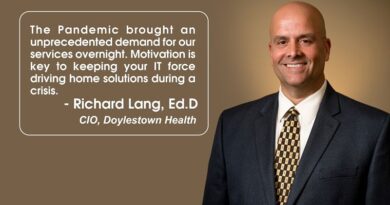Telehealth: For HIM Professionals, Challenges Worth Meeting
By: Katherine Lusk, MHSM, RHIA, FAHIMA, Chief Health Information Management & Exchange Officer at Children’s Health in Dallas
Telehealth has been growing in practice for years, with the COVID-19 pandemic and its required social distancing accelerating adoption. There are many benefits to telehealth, but it can present challenges for Health Information Management (HIM) professionals.
These challenges include ensuring integrity and confidentiality are maintained and that a provider’s scope of practice is within the legal statutes set forth by the state where they’re practicing. It’s also important that diverse payer coding guidelines are followed. In addition, organizations must determine who is responsible for documenting patient information and how that information is shared.
Health Information Management professionals should educate providers and staff on the relaxed HIPAA rules including the difference between secure and nonsecure connections.
It’s worth it to tackle these challenges because as we’ve seen during the pandemic, telehealth can be a lifeline in difficult times – and come in handy during brighter days. Telehealth makes it easier for patients to receive a second opinion or be regularly monitored for issues like cardiac health, medication adherence, and behavioral health therapy. Perhaps the top benefit of telehealth is access to care during social distancing and for people who live in underserved areas where there aren’t as many providers. School-based programs are another great use of telehealth – they benefit schools by keeping kids in the classroom, allowing families to stay at work, and decreasing unnecessary emergency room utilization. Meanwhile, children benefit from more class time and better health. Telehealth takes healthcare to where families live, work, play, and learn.
Time saved is a benefit of telehealth. Patients and even providers don’t have to commute to an appointment, and patients can sometimes see a specialist in a shorter amount of time than if they had to wait for an in-person appointment. Money saved is another benefit. Telehealth can reduce cost efficiencies through shorter hospital stays and better chronic disease management.
Finally, as a Health Information Management (HIM) professional and the president/chair-elect of the American Health Information Management Association (AHIMA), I’m particularly excited that telehealth can lead to improved access to health records and information. If we make more health information available online, we empower people in the management of their health, shifting the paradigm from brick and mortar care to a more consumer-centric care delivery model. In addition, we should promote online discussion groups for both patients and health professionals, because as we have learned during COVID-19, connection is everything – even if it’s virtual.
Telehealth during COVID-19
With stay at home orders impacting many states, it’s not surprising that providers and patients would both seek ways to meet virtually. On March 17, the U.S. Department of Health and Human Services published guidance that relaxes HIPAA rules related to telehealth during the pandemic. The guidance allows providers and patients to meet over commonly used platforms like Apple’s FaceTime, Facebook Messenger, Google Hangouts, and Skype. Two-way conversations are allowed on these channels – what isn’t allowed is speaking on more public-facing platforms like Facebook Live or TikTok. Health Information Management professionals should educate providers and staff on the relaxed HIPAA rules including the difference between secure and nonsecure connections.
The Centers for Medicare and Medicaid Services support of payment for telehealth services has been rapidly adopted by the payer market. However, issues for HIM professionals have emerged because there are differing opinions on which CPT 4 codes should be utilized to classify services delivered. It seems as if the payers are changing their views daily, which burdens HIM professionals. I hope this is sorted out soon.
The Importance of Documentation, Privacy, and Security
Whether a provider and patient are meeting in person or virtually, the importance of accurate clinical documentation remains. HIM professionals should work with medical staff to ensure the organization continues its high standards for documentation. In fact, as regulations remain fluid around telehealth, documentation will be more important than ever. Post-pandemic documentation will be vital for helping organizations ensure that accurate billing, coding, and public health reporting occur.
Of course, HIM professionals, providers, and staff need to remain cognizant of the Health Insurance Portability and Accountability Act, more commonly referred to as HIPAA. AHIMA recommends HIM professionals create a fact sheet for their organization’s staff that reminds them about the importance of confidentiality and access.
HIM professionals should also remain vigilant against cyber scams. The Cybersecurity and Infrastructure Security Agency said cyber actors might send emails with malicious attachments or links to fraudulent websites in an effort to trick victims into revealing sensitive information. All staff should exercise caution in handling any email with a COVID-19-related subject line, attachment, or hyperlink, and be wary of social media pleas, texts, or calls related to COVID-19.
In Conclusion
I’m excited to see how telehealth impacts the future of healthcare. I suspect many patients and providers who took advantage of it during COVID-19 will want to continue in the coming years. HIM professionals stand ready to help their organizations ensure clinical documentation integrity remains in a new and different – but exciting – healthcare ecosystem. A system in which people are empowered in the management of their wellness and receive care where they live, work, play, and learn.



